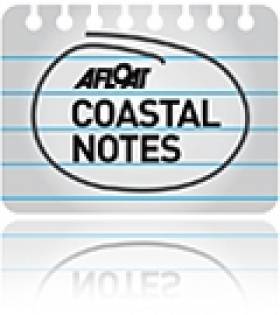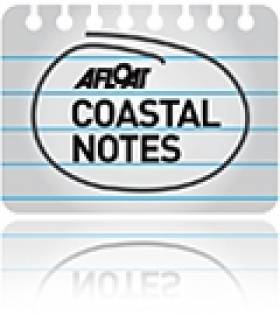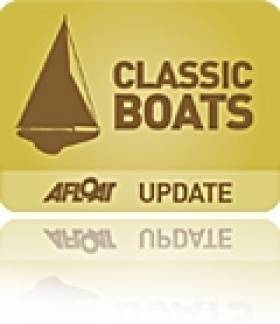Displaying items by tag: heritage
Naomh Éanna's Fate In Balance As Survey Draws Near
#NaomhEanna - The fate of heritage vessel Naomh Éanna still hangs in the balance as moves are made towards a structural survey of the former Aran Islands ferry.
As previously reported on Afloat.ie, the historic boat has been earmarked for scrapping - with both Waterways Ireland and the Department of Heritage said to be reluctant to have anything to do with the restoration of the vessel, which has resided at Grand Canal Basin in Dublin Port since 1989.
Despite this, campaigners have pushed ahead with their efforts to save what's believed to be one of the last surviving riveted ships and give her a new lease of life at a berth in Galway Harbour, a vision outlined in their €1.85 million business plan put together in a race against time.
The first step in this process is to survey the vessel in dry dock, at a cost of some €15,000 to the Naomh Éanna Trust's Save Our Ship (SOS) campaign - which has so far raised funds via a public appeal to pay for divers, workers and small plant hire, as well as insurance and waste disposal.
Sam Field Corbett, of Irish Ship & Barge Fabrication and a key figure in the campaign, says he has now received word from Heritage that the department is willing "to facilitate a proper survey" provided the campaign covers "reasonable costs involved" and "any additional expenses" in preparing the vessel in dry dock for Waterways Ireland's disposal plans, should the survey bring bad news.
The next stage is to pump out the water from the vessel before attempting to access the lower tanks and verify if her frames and internal keel structures are salvageable.
If they are, the minister has requested the SOS campaign to determine if planning would be required to repair the ship's hull in the graving dock. If not, the boat will be allowed to fall over in the dock, after asbestos removal, and ultimately destroyed.
"I was greatly disappointed more support was not forthcoming for what we can see as the preservation of our maritime and Dublin city's industrial heritage, not to mention the job creation possibilities," said Field Corbett.
#LoughCorrib - Experts surveying a site in Lough Corrib have found a wealth of ancient water craft and other artefacts, including a log boat dating back some 4,500 years.
As The Irish Times reports, Heritage Minister Jimmy Deenihan has described as "exceptional" the finds that include vessels from the Bronze and Iron Ages, as well as medieval craft and weapons of the style used by Viking settlers.
But the star of the show is surely the Annaghkeen log boat, a dugout canoe made from a single massive tree trunk that's almost identical to the similarly aged Lurgan log boat, which was found not far away in Co Galway over a century ago and now housed in the National Museum at Leinster House.
It's now being posited that both boats, as well as the Carrowneden boat found near Ballyhaunis in 1996, may be the work of the same builder.
The Irish Times has much more on the story HERE.
Name That Stream! Blackrock School Pupils Need Your Help
#InlandWaterways - Can you help pupils at Blackrock's International School Dublin identify the stream behind their building?
The 9-to-12-year-olds in Miss Nelson's class have been researching the natural history of the neighbourhood surrounding their school in South Co Dublin, but have been stumped by the stream that runs behind the school building.
The narrow waterway runs north through St Louise's Park and alongside Barclay Court before going under and through Blackrock. Visible on many online maps, it's only labelled by name on one as the Carysfort-Maretimo Stream.
Miss Nelson's class are hoping any locals reading this can confirm if their stream is indeed known by that name, and any other information about it such as its history, where it rises and where it flows.
If you think you can help, please leave a comment below!
#NaomhEanna - Campaigners for the preservation of the heritage vessel Naomh Éanna have said their meeting with the Heritage Minister this week "could not be described as constructive".
Last Wednesday the Naomh Éanna Trust's Save Our Ship (SOS) campaign and marine restoration firm Irish Ship & Barge Fabrication Co presented their business plan for the restoration of the former Aran Islands ferry, said to be one of the world's last surviving riveted ships.
TheJournal.ie has more details from the €1.85 million business plan, put together in just four weeks, with artist's renderings of what the Naomh Éanna might look like once converted for use as a floating restaurant with a boutique hostel, a museum and event a micro-brewery, upon relocation to a new berth in Galway Port.
The Naomh Éanna is currently in dry dock at Grand Canal Dock, where she has resided for some 25 years, awaiting a final decision on her fate after Heritage Minister Jimmy Deenihan granted a Seanad-prompted reprieve till tomorrow 31 March.
Sam Field Corbett, of Irish Ship & Barge Fabrication and a key figure in the campaign, said the "comprehensive" plan was just the first step in a process that now requires a proper survey of the vessel before outside investors can be sought for a project that could employ 50 people.
But he has since expressed frustration at the State’s position following the meeting on Wednesday 26 March, claiming that “the main thread of feeling on the minister’s side rested on avoiding any unnecessary expenses or responsibilities being incurred by the State.”
Field Corbett said: "I understand there is some doubt in the minister's department as to the heritage value of the Naomh Éanna. As she is not yet a 100-year-old 'wreck' she is afforded no protection from the minister's department."
Moreover, he said those in attendance - including Minister Deenihan, senior officials from his department and a senior member of Waterways Ireland - "all agreed the proposed business was impressive and workable, yet of little concern of theirs."
For now the Naomh Éanna will remain in dry dock at the campaign's own expense, while a public appeal is being prepared to raise funds for the "essential" comprehensive vessel survey.
Ireland's West Coast – Special Boats & Big Hearted Sailors
#historicboats – These days we're told of the growing disparity between the economic recovery of Ireland's eastern region, and the relative economic stagnation of some of the rest of the country. But W M Nixon suggests that, for one part of the western seaboard at least, there's a special vitality to life around boats which challenges this perception, and could usefully be emulated elsewhere. And he signs off with a thought-provoking conclusion.
Connemara, Conamara. Spell it as you wish, but The Land of the Sea on Connacht's most westerly coast fires the imagination and inspires the spirit. It's a place of the mind as much as a place of wild mountains where rocky inlets wind their way deep into rugged country. So while purists might define it exclusively as the much intertwined coastline with its myriad islands between Spiddal and Killary, many of the rest of us can be so inspired by that special Connemara quality that we reckon it runs all the way from Galway Bay to Achill. And anyone from that magic coastline, or indeed anyone who has been inspired by it, carries the spirit of Connemara with them wherever they may be.
The boat people you meet out there, each with their own unique and often ambitious maritime agenda, will send you on your way re-enthused about boats and places and their many possibilities. And when someone from another place or indeed another country decides that it's in Connemara their true self and fulfilment is to be found, far from being seen as exiles they are instead seen as a new focal points for their old groups, and their soul-mates from times past descend on them in Connemara for inspiration and mental re-birth.
This weekend, the boat men from Clondalkin in outer Dublin are journeying to Renvyle on the furthest far west coast to help one of their own in his boat restoration programme at a storm-battered corner on a bit of coast which was almost washed away in the winter's seemingly endless climatic violence.
The men of Clondalkin are the community group who built and sail and continue to lovingly maintain the large Galway Hooker Naomh Cronan. Recently, they've been busy enough with replacing some planks on their hefty big boat. But their key organiser Paul Keogh is mindful of the fact that one of their own, Paddy Murphy, is in the west, living on an Atlantic point out beyond the old Oliver St John Gogarty house which is now the hotel at Renvyle.
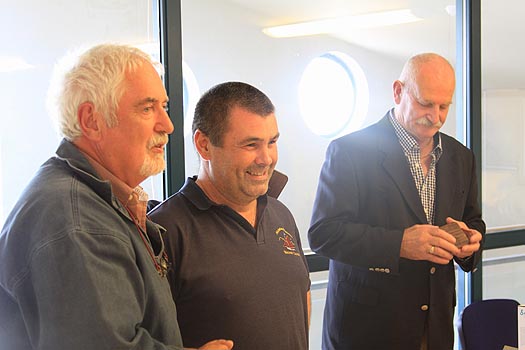
They dreamed the dream, and they made it happen. Key movers in the Naomh Cronan story were Stiophan O Laoire (left) and Paul Keogh, seen here at Poolbeg Y & BC as they come forward to accept a prize on behalf of the crew from Johnny Wedick, Hon. Sec. of the Dublin Bay OGA. Photo: Dave Owens
And between Paddy's house and the sea, beside a little hidden slipway which serves small boats which undertake the risky but rewarding challenge of harvesting Ireland's most fish-filled waters, the restoration project on the Aigh Vie is proving to be a demanding task. So this weekend the Keogh team – precise numbers unknown until everyone checks in this morning – are on site to re-caulk the Aigh Vie in a wild weekend of communal energy.
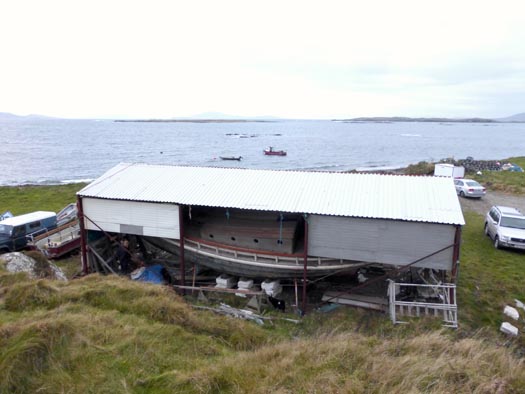
On the Atlantic frontier at Renvyle, the Aigh Vie is under her roof, tilted over to port to facilitate work under the starboard side of the hull. Photo: W M Nixon
For the Aigh Vie is one very special vessel. She's one of the Manx fishing nobbies which reached their ultimate state of development in the first twenty years of the 20th Century before steam power and then diesel engines took over. The nobby evolved to an almost yacht-like form through vessels like the 43ft White Heather (1904), which is owned and sailed under original-style standing lug rig by Mike Clark in the Isle of Man, and the 1910 Vervine Blossom, now based in Kinvara, which was restored by Mick Hunt of Howth, but he gave her a more easily-handled gaff ketch rig which looked very well indeed when she sailed in the Vigo to Dublin Tall Ships Race in 1998.
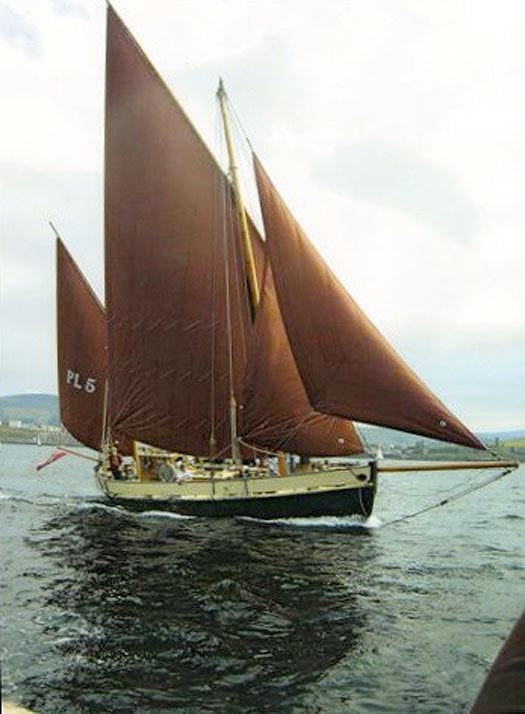
Mike Clark's Isle of Man-based 1904-built Manx nobby White Heather sets the original standing lug rig.
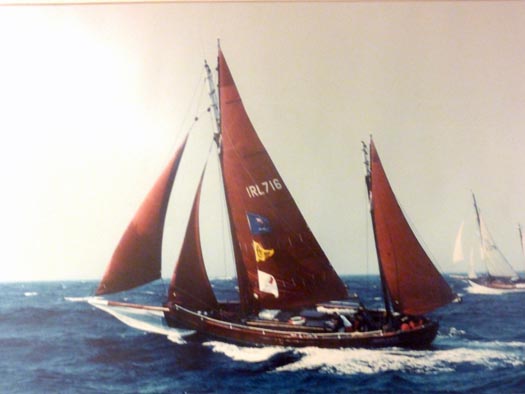
The 1910-built Manx nobby Vervine Blossom was restored by Mick Hunt in Howth, and is seen her making knots under her gaff ketch rig at the start of the 1998 Tall Ships Race from Vigo to Dublin. Photo: David Branigan
It takes quite something to outdo the provenance of these two fine vessels, but the story of Aigh Vie (it means a sort of mix of "good luck" and "fair winds" in Manx) is astonishing. It goes back to the sinking of the Lusitania by a German U Boat off the Cork coast in May 1915, when the first boat to mount a rescue was the Manx fishing ketch Wanderer from Peel, her crew of seven skippered by the 58-year-old William Ball.
They came upon a scene of developing carnage. Yet somehow, the little Wanderer managed to haul aboard and find space for 160 survivors, and provide them with succour and shelter as they made for port. In due course, as the enormity of the incident became clear, the achievement of the Wanderer's crew was to be recognised with a special medal presentation. And then William Ball, who had been an employee of the Wanderer's owner, received word that funds had been lodged with a lawyer in Peel on behalf of one of the American survivors he'd rescued. The money was to be used to underwrite the building of his own fishing boat, to be built in Peel to his personal specifications, and the result was his dreamship, the Aigh Vie, launched in 1916.
Over the years, the Aigh Vie became a much-loved feature of the Irish Sea fishing fleet. Tim Magennis, current President of the Dublin Bay Old Gaffers Association, well remembers her from his boyhood days in the fishing port of Ardglass on the County Down coast. In time, she was bought by the legendary Billy Smyth of Whiterock Boatyard in Strangford Lough, who gradually converted her to a Bermudan-rigged cruising ketch with a sheltering wheelhouse which enabled the Smyth family to make some notable cruises whatever the weather. His son Kenny Smyth, who now runs the boatyard with his brothers and is himself an ace helm in the local 29ft River Class, recalls that the seafaring Smyth family thought nothing of taking the Aigh Vie to the Orkneys at a time when the average Strangford Lough cruiser thought Tobermory the limit of reasonable ambitions.
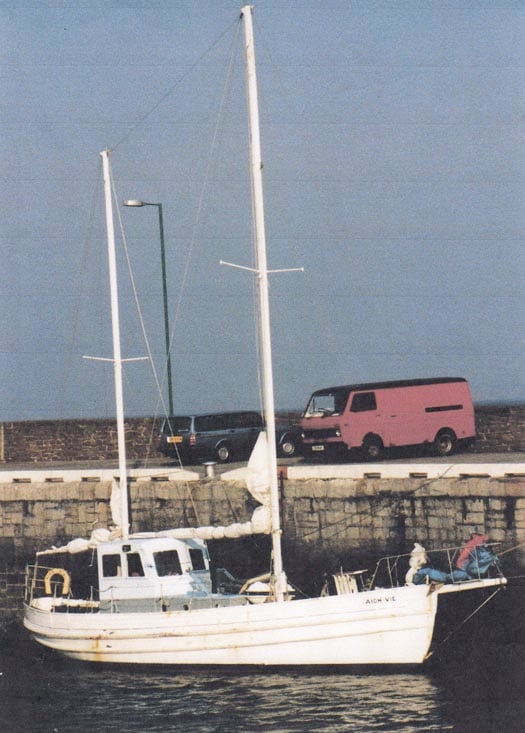
Aigh Vie as she was when bought by Paddy Murphy from Billy Smyth of Strangford Lough.
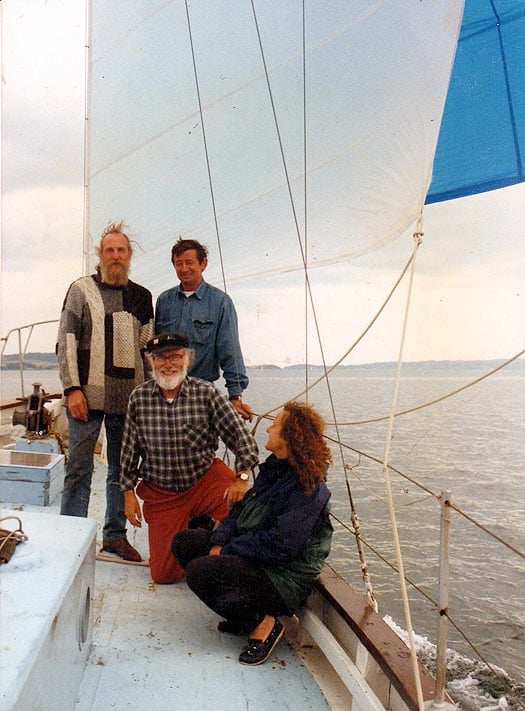
First sail with the newly-bought ship. Aboard Aig Vie heading for Dublin down Strangford Lough, the crew includes Paddy Murphy (left) and Tim Magennis (centre)
It's some years now since Paddy Murphy bought the Aigh Vie, and sailed her back to Dublin with his crew including Tim Magennis. But around the same time, Paddy was moving his base west to Renvyle, where he reckoned his skilled trade as a blacksmith, and his talents in traditional music and folklore, would provide him with a living in the area where he felt most at home.
As for the Aigh Vie, clearly she was reaching an age where work needed to be done. And he was minded to restore her to something more nearly approaching her original 1916 configuration. So somehow or other, he took the big boat west on a truck, managing to negotiate those little winding roads through Tully Cross and down to his place by the sea, where she went under a roof and work began.
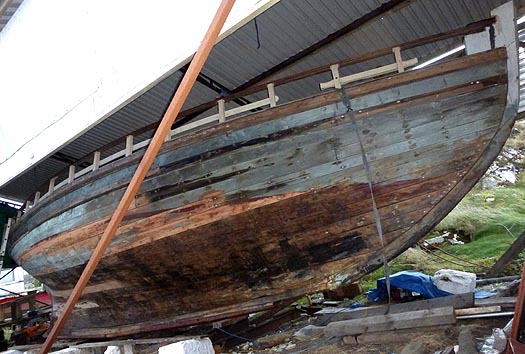
The hull of the 1916-built Aigh Vie as seen in Renvyle shows the remarkably yacht-like lines of the Manx nobby.........Photo: W M Nixon
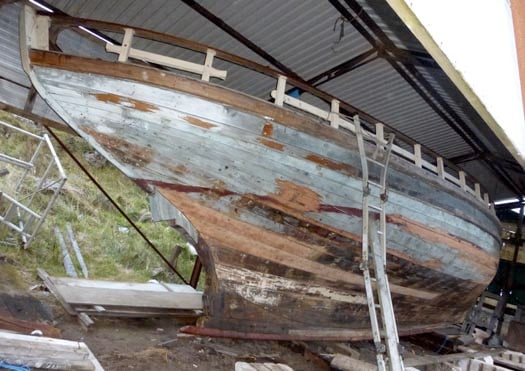
.........in what was one of the last of the sailing type to be built before steam power took over. Photo: W M Nixon
It has been going on for some time now. The problem with being right on the frontier of Ireland's Atlantic weather is that no sooner do you start on some new area of timber repair and replacement, than the previous restoration section almost immediately starts to become weathered. Working largely on your own, you end up feeling you're going round in circles. So that's why the men from the Naomh Chronan are in Renvyle today to give the Aigh Vie project a mighty push forward.
For there's no doubt that while there's a lot done, there's a lot more still to do. But it does get done eventually if you keep the faith, and I was there back at the beginning of December to cheer Paddy along with all the usefulness of a hurler on the ditch. But at least I was accompanied by Dickie Gomes, who knows a thing or two about long-term boat restoration, as it took him 27 years to bring his 102-year-old Ainmara successfully back to life. But he did it so well that she won the Creek Inn Trophy for "Best in Show" at last summer's Peel Traditional Boat Weekend in the Isle of Man.
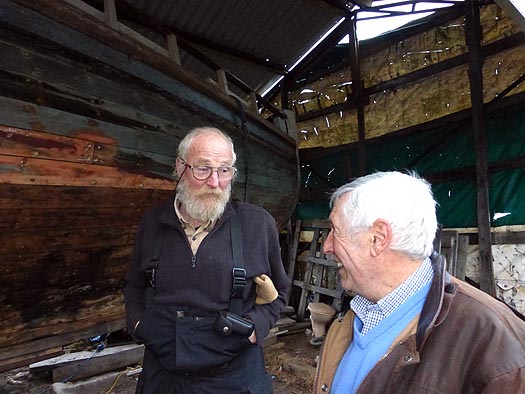
A bit of mutual support between two owners of vintage wooden boats – Paddy Murphy and Dickie Gomes in Aigh Vie's shed at Renvyle. Photo: W M Nixon
Nevertheless I've to confess that sometimes I wonder if wood is worth the trouble. Before getting to Renvyle, we'd called by with Jamie Young at Killary Adventure Centre for bit of a love-in with his alloy-built Frers 49 Killary Flyer which - as Brian Buchanan's Hesperia IV - was winner of the Round Ireland Race 1988 under the command of Dickie Gomes. Except that you won't see that fact in histories of the Round Ireland. Because for 1988's race, she sailed as the sponsored entry Woodchester Challenger, and thus was not entitled to the top prize, despite having the best corrected IOR time in the fleet.
But everyone in the know knows that Gomesie won, particularly the crew of Denis Doyle's slightly larger Frers sloop Moonduster. The two boats had been neck and neck running past the Blaskets, and suddenly Hesperia's spinnaker shredded. But Dickie had his crew so well drilled that one half of them had a replacement chute up and drawing before the other half had finished getting in the remains of the torn sail. The boat scarcely missed a beat in her rapid progress, and when the whole business was completed in about three minutes flat, there was a round of applause from Moonduster. You'd sportsmen doing the Round Ireland in those days.
As it happens, one of Hesperia's crew for that neat bit of work was Kenny Smyth, so it made it more than appropriate that we were going on to see the Aigh Vie on which he cut his offshore sailing teeth. But it was good to linger for a while at Jamie's snug place, and marvel at how he, with aid from the ingenious folk of the west, had contrived a slip and an angled trolley so that Killary Flyer can be hauled on site into a sheltered corner, for she's a big lump of a boat to be handling ashore.
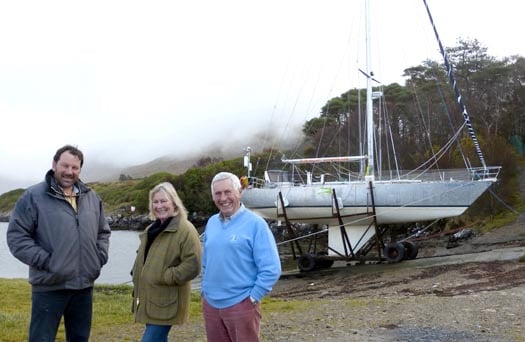
She's a big boat to be hauling on a slip in a remote corner of Mayo. Early December beside Killary Fjord, and Jamie Young of the Adventure Centre with Deirdre and Dickie Gomes and the Frers 49 Killary Flyer ashore for the winter. Deirdre was a fulltime member of the boat's crew when Dickie successfully skippered her offshore as Brian Buchanan's Hesperia IV. Photo: W M Nixon
It was some time in the New Year that we heard the shocking news. One of the most severe storms had twirled the Flyer up like a toy boat from her sheltered corner, and deposited this Frers masterpiece on her ear. Jammed in against the steep shore, she was trapped as the tide came in, and the hull was flooded with severe damage to the electrics and electronics.
But this is the west, where they're accustomed to overcoming massive challenges. The extraordinary Tom Moran of Clew Bay Boats played a key role in a salvage project which saw a temporary road being built so that a giant crane could be positioned for the delicate job of inching the big boat back upright. That done, she could then be moved to Tom's place at Westport for restoration to begin.
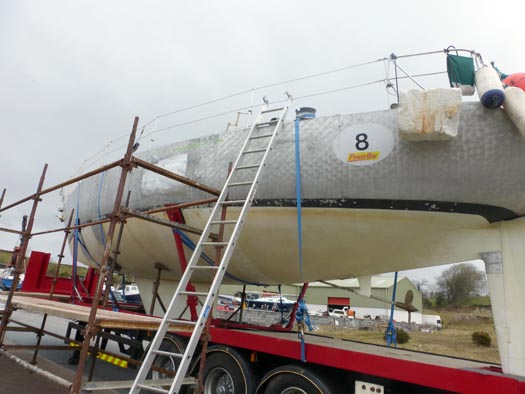
A couple of dents in aluminium? No problem. Following her brief episode of aviation, Killary Flyer's hull is already made good at Clew Bay Boats in Westport. Photo: W M Nixon
The whole business has been a marvellous advertisement for the effectiveness of hull construction using modern marine alloys. When aluminium was first created as the "Metal of the Future" two centuries ago, only the Emperor Napoleon could afford to have a cutlery set made in this exotic stuff. And though an early alloy boat put afloat in Lake Geneva performed reasonably well, as soon as a boat built with it was put into the salty sea, it just melted away.
But over the years the formulas have been adjusted to be corrosion proof in sea water, such that nowadays it's the ideal material for little boats which are going to have hard usage yet little maintenance, such as angling boats and the nippy craft used by rowing coaches.
And if you have a low-maintenance alloy hull yet give it a bit of cosmetic attention, it will look very well indeed, but it's not essential. As for the rough and tumble of life afloat, if you crash into a quay wall with a traditionally built wooden boat, she'll become shook from bow to stern – you never really know where the underlying structural damage ends, if at all. As for GRP and carbon or whatever, the damage will be more localised, but it still gets holed, and messily with it at that, while bulkheads may shift to an unknown degree
But a steel or aluminium hull will generally just be dented, and very locally at that. Repairs are manageable, even if it's skilled specialist work. So there's a lot in favour of steel and alloy. But steel rusts, and it never rusts quicker than in hidden pockets in the structure. But with remarkable advances in alloy welding and building techniques, the advantages of modern corrosion-free alloy construction become more evident every year for boats that are really going to be used, and not just seen as marina ornaments.
The Killary Flyer experience is ultimately a telling argument in favour of alloy construction. The hull was only dented in a couple of places where it was actually in direct contact with outcrops on the foreshore. Any dents have already been repaired by Tom Moran and his team, for they're able for anything to do with boats in any sort of material - I reckon if you wanted to build your dreamship out of resinated peat moss, then Tom would be game for the job.
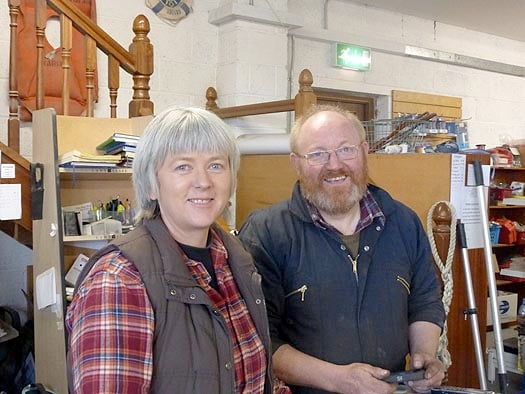
Can-do people of the west – Mary and Tom Moran of Clew Bay Boats have successfully taken on many marine problems and projects. Photo: W M Nixon
Sorting out the interior systems is going to be more of a challenge, for Hesperia was originally Noryema X, built for Ron Amey in 1975. In a sense, there's a feeling of homecoming in the fact that she's being restored in Westport. If you head directly inland from that lovely little town, you're soon up in the mountains in the Joyce Country. And way back in 1975, the alloy hull of Noryema X was built by the renowned Joyce Brothers. Their fabrication workshop may have been in Southampton, but the family wasn't that long out of the mountains of far Mayo.
However, once the innovative Ron Amey had taken delivery of the hull of his latest Noryema from the brothers Joyce, he then took it to Moody's big shed at Bursledon on the Hamble for completion by the boatyard's craftsmen. I happened to be Bursledon-based in the early summer of 1975, and it really was all a wonder to behold.
Amey had installed a caravan in Moody's shed, and he lived in it while overseeing every detail of the new boat's fitout, while at the same time running his business empire of Amey Roadstone from a telephone in the caravan. It was said that the great man wouldn't be really happy with his new boats until the final jobs were completed just before the Fastnet Race in August, and after that he'd then start to think of the next one. But Noryema X was something special. She became the last of the racing line, and despite her enormous rig, Ron Amey then used her for eleven years of cruising in the Mediterranean which concluded with her sale to Brian Buchanan of Belfast Lough at Marseilles in 1986. She has been based on our island ever since, the source of much seagoing pleasure for hundreds of Irish sailors.
So bringing her back up to Amey standards is quite a challenge, as she's now part of Ireland's sailing heritage. But with Tom Moran they've someone who seems to have links with every maritime specialist in the country, and if he draws a blank in Ireland, his connections around the Solent marine industry seem pretty hot too.
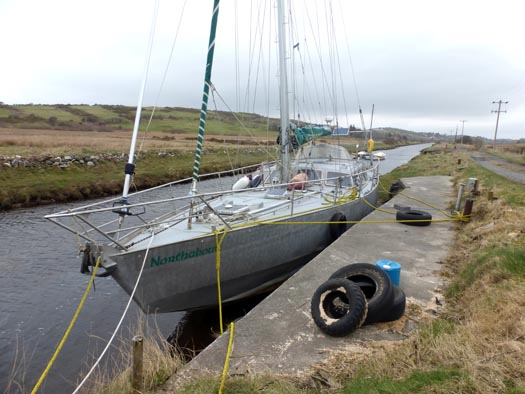
Not quite where you'd expect to find an Arctic voyaging vessel, but Northabout seems at home in the Moylure Canal in the midst off Mayo fields. Photo: W M Nixon
Much encouraged by all this, for Clew Bay Boats is the sort of place where many good things seem possible, we then headed down to the Moylure Canal, a drainage waterway near Rosmoney at the head of Clew Bay where the great Jarlath Cunnane has created a tiny boat harbour and beside it a little place where, if so minded, he can build himself a boat.
Jarlath is the quintessential Connacht mariner, yet you'll never find him being sentimental about wooden boats. On the contrary, in the time I've known him he has built himself a steel van de Stadt 34ft sloop which he cruised very extensively, and more recently he took on the challenge of alloy construction to build the 44ft Northabout. Aboard this special boat, in teamwork with Paddy Barry, he has made cruises to remote and challenging places in voyages which, for most people, would have required full military logistical support.
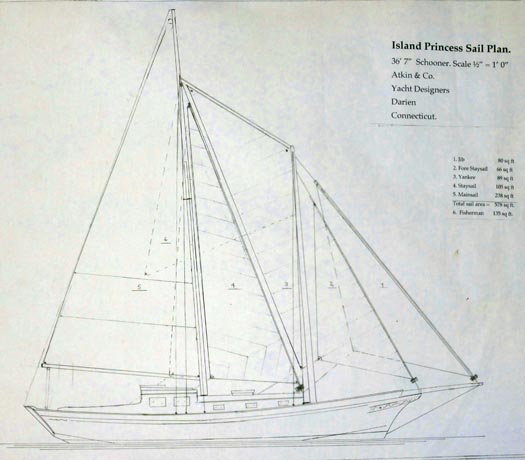
The new dreamship. Plans of the 37ft Atkins schooner which Jarlath Cunnane has been building over four years.
Knowing the scale of what he has done with her, it was bizarre to see Northabout sitting modestly in her berth in the little creek beside a Mayo field. But the presence of the long distance high latitude voyager was only part of the Moylure package. A few feet away in "the shed which isn't really a shed" was the new Cunnane boat, a sweet 37ft–Atkins schooner which, if you haven't yet appreciated the potential of good alloy boat construction, would surely win you over in a trice.
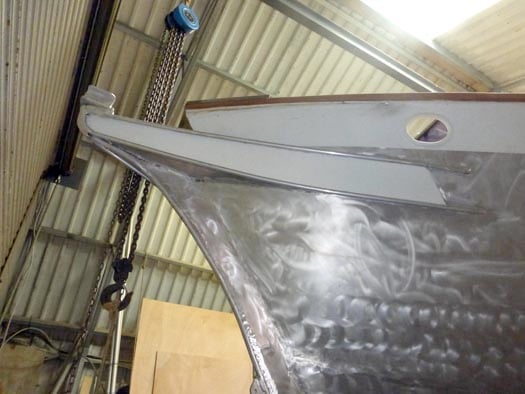
Good alloy construction, as seen here in the stemhead of the new schooner, can withstand comparison with any material. Photo: W M Nixon
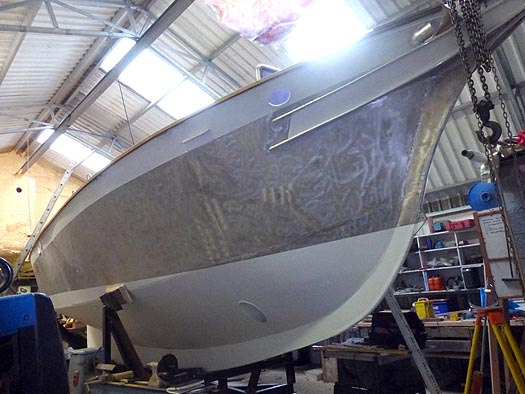
The new schooner has a workmanlike and handsome hull......Photo: W M Nixon
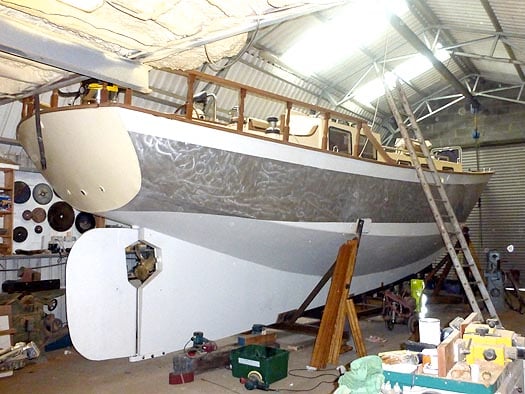
....which is aimed for comfort as much as speed, but she should be able to give a good account of herself in performance, and will be very comfortable for longterm periods on board. Photo: W M Nixon
Jarlath has taken four years on the construction, and when he gets to sailing the new boat, I'd say that the motto will be: "When God made time, he made a lot of it". This is a boat for leisurely cruising, a boat to enjoy simply being on board. In her finished state, she'll give little enough in the way of clues as to her basic construction material. Like Killary Flyer, and like Northabout too, she is in her own way a great advertisement for the potential of good alloy construction.
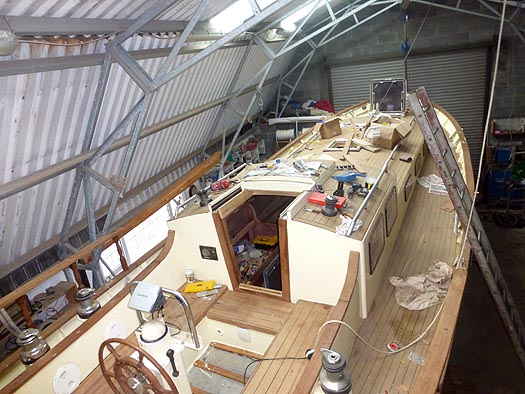
As completion nears, it becomes ever less apparent......Photo: W M Nixon
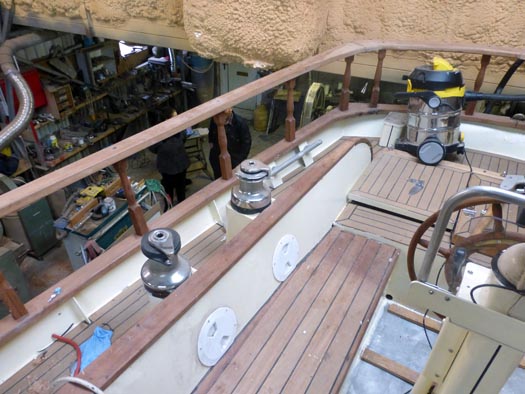
.....that the hull construction of the new schoner is in aluminium. Photo: W M Nixon
So we'll sign off this week with a special thought. As Irish life begins to move again, doubtless we'll soon hear increasing mutterings about the desirability of building a new Asgard sail training brigantine. Maybe we should keep the government out of it this time round, and build her through a voluntary trust organisation supported by public subscriptions and corporate donations. But however it's to be done, we should be starting to think about it.
And like many others, I've long thought that the ideal way forward would be with a steel hull built to Jack Tyrell's original Asgard II lines, which have a magnificently timeless quality to them. But I've changed my mind on that. Having seen what can be done with good alloy construction down in Mayo, and knowing the quality of alloy workboat construction being produced by firms like Mevagh Boatyard in Donegal and by the descendants of Jack Tyrrell among others at Arklow Marine Services in County Wicklow, it's difficult to escape the conclusion that the hull of the new ship should be built in aluminium.
It would be initially expensive, but it would confer great longterm maintenance advantages. And by going that way, we'd be able to provide all the double skins and safety bulkheads which will now be required without using up all available hull space, and without producing a boat so heavy she wouldn't be able to sail out of her own way. So let's hear it for an aluminium-hulled Asgard III.
#BelfastLough - Eight hundred years of history on the shores of Belfast Lough have come to light thanks to a new archaeological dig at Carrickfergus Castle.
As the Belfast Telegraph reports, the fortification dates from Anglo-Norman times and is the best preserved site of that era on the island of Ireland, allowing experts to fill in a detailed picture of life in the Middle Ages.
The latest excavations are in the oldest part of the castle, the great hall where Anglo-Norman knight John De Courcy would have feasted.
But additional discoveries in the earth mean we're also learning more about a later resident, Arthur Chichester - the man credited with the founding of Belfast in the Elizabethan Era.
The Belfast Telegraph has much more on the story HERE.
Storms Uncover Ancient 'Drowned' Forest On Galway Coast
#CoastalHeritage - First the recent storms exposed the wreck of a century-old schooner in Co Kerry and the remnants of neolithic graves in Connemara.
But now the severe weather has revealed the existence of ancient forests dating back an incredible 7,500 years.
The Irish Times reports on the incredible discovery on the Galway coast west of Spiddal, where the remains of a 'drowned' forest have been uncovered.
What's most remarkable about the find is that the trees' root systems are still intact, untouched since the Holocene times when wolves and bears where in abundance in Ireland's wild.
The Irish Times has much more on the story HERE.
Month's Reprieve Not Enough Say Naomh Éanna Campaigners
#NaomhEanna - Campaigners behind the effort to save the heritage ship Naomh Éanna have expressed their disappointment at what they claim is too short a stay of execution for the vessel.
Last Thursday (27 February) the former Galway Bay ferry was granted a one-month reprieve from the scrapheap, following the intervention of the Seanad, to allow interested parties to put together a comprehensive business plan for the vessel.
But Sam Field Corbett, of the SaveOurShip campaign and marine heritage restoration business Irish Ship & Barge Fabrication, said it had been made clear before last week's debates in Leinster House that 16 weeks would be required to prepare such a plan "involving no State funding".
The Naomh Éanna, said to be "one of the last riveted ships built in the world", has spent the best part of three decades in a state of neglect at Grand Canal Dock after her retirement from the Galway-Aran Islands ferry route.
She was destined for the junkyard early last month before the intervention of Seanad members, despite the Department of Heritage rejecting appeals to save her.
Corbett said the four-week window of reprieve rules out the possibility of the Naomh Éanna remaining in the capital, but was happy to report that a berth had been confirmed in her old home of Galway Port.
"Engineers are confident that, after restoration of her hill and machinery, she will sail to Galway under her own steam," he said, noting that "surveyors will continue to quantify the cost of restoration, to be confirmed when the ship is dry-docked."
He also added that designers from his boat restoration business had surveyed the shop and proposed a variety of future uses for the vessel, including a café/bakery and restaurant, a "boutique hostel" and even a microbrewery.
Meanwhile, an online petition has been launched to urge Government to extend the Naomh Éanna's life beyond the present 31 March deadline.
'Millions' Not Needed To Combat Erosion Threat To Ireland's Coastline Says Academic
#CoastalNotes - Solutions to deal with the erosion of Ireland's coastline to not have to cost "millions", a geography lecturer tells The Irish Times.
The comments by University College Cork's Dr Max Kozachenko follow a less heartening scenario described by fellow UCC academic Prof Robert Devoy, who said last month that erosion rates - exacerbated by increasingly extreme weather - will soon force Ireland's coastal counties to look "very clinically" at what parts are most worth saving via expensive engineering works.
However, Dr Kozachenko says that such a take-it-or-leave-it solution is "simplistic" when a co-ordinated approach involving coastal monitoring and new approaches to managing the effects of wind and wave action could stem the damage to Ireland's coastline for little expense.
He cites the placing of rock fragments in front of protective rock armouring or concrete walls to scatter waves and dissipate their energy as a cheap but effective option, and also notes the success of offshore artificial reefs in Japan that have had the added benefit of assisting in biodiversity.
The Irish Times has much more on the story HERE.
'Save Naomh Eanna' Campaign Courts TDs To Support Heritage Ship's Future
#NaomhEanna - Campaigners hoping to preserve the heritage ship Naomh Eanna have circulated a letter among Dublin TDs to gather support for their restoration plans.
Earlier this week Afloat.ie reported that the vessel, described as the 'last Irish heritage ship', is set to face the scrapheap after spending the last 28 years in a state of neglect at Grand Canal Dock.
Now the Save Naomh Eanna campaign has called on local TDs to put their weight behind a 16-week reprieve for the derelict ship so that a business plan for its restoration can be put together.
Save Naomh Eanna argues that cutting up the ship in the Grand Canal graving dock poses an environmental risk to the waters at the dock as well as a physical risk to the 200-year-old dry dock itself, listed as a protected structure.
The campaign also claims there are "irregularities" in the manner by which Waterways Ireland intends to dispose of the vessel, of which it recently took possession.
































